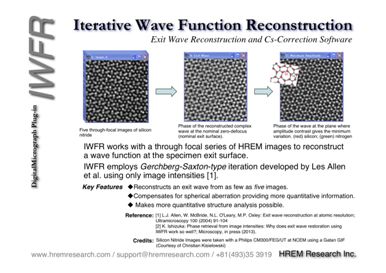The Iterative Wave Function Reconstruction (IWFR) method uses a set of image intensities measured in different planes (a through-focal series), and reconstructs the complex wave at the specimen exit surface (at the zero-defocus plane).
This method requires few images, as few as five will suffice, in contrast to other methods, such as the MAL method (TrueImage by FEI), that requires usually twenty images.
Using the reconstructed wave function you can correct optical aberrations, e.g. spherical aberration. Therefore, the IWFR is a software Cs-corrector.
References and Technical Notes
- * Phase retrieval from image intensities: Why does exit wave restoration using IWFR work so well? (Microscopy ) (OUP site)
- *L.J. Allen, W. McBride, N.L. O’Leary, M.P. Oxley: Exit wave reconstruction at atomic resolution; Ultramicroscopy 100 (2004) 91-104.
- Validity of IWFR to reconstruct an Exit Surface Wave (M&M2006, Chicago) (PDF)
- Why does Exit Wave Restoration using IWFR work so well? (IMC16, Sapporo) (PDF)
Examples (Sample Data)
Download
You have to purchase a license (hardware key) to run this program.
Please send your price enquiry to support@hremresearch.com.
- IWFR v2.1
for GMS 3.6 (64bit)
for GMS 3.5 (64bit)
for GMS 3.4 (64bit)
for GMS 3.3 (64bit)
for GMS 3.2 (64bit) (applicable from GMS 3.0)
for GMS 2.3 64bit
for GMS 2.1 64bit (applicable from GMS 2.0)
Required plug-ins.
User Key Driver
Previous versions
- IWFR v2.0.4
for GMS 3.6 (64bit)
for GMS 3.5 (64bit)
for GMS 3.4 (64bit)
for GMS 3.3 (64bit)
for GMS 3.2 (64bit) (applicable from GMS 3.0)
for GMS 2.3 64bit
for GMS 2.1 64bit (applicable from GMS 2.0)
HREM News
Please Subscribe to the HREM News to get latest information on this plugin.
Note: If you have already subscribed to the HREM News, please don't subscribe again.
